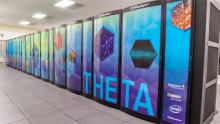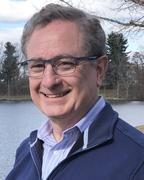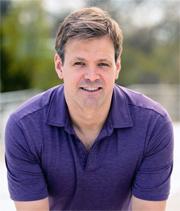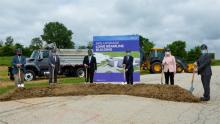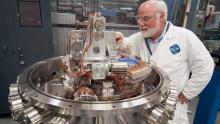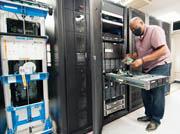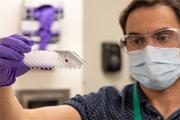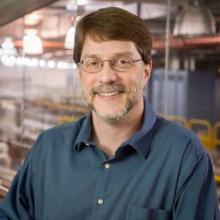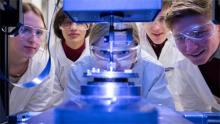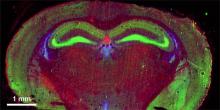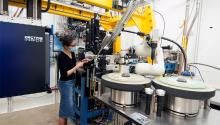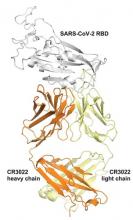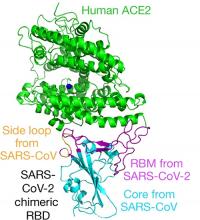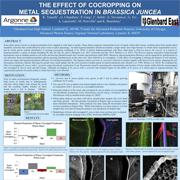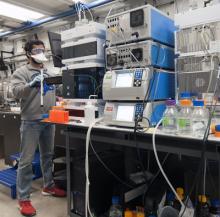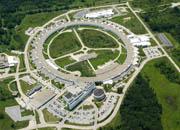News Feed - APS/User News
Ming Du and Chris Jacobsen have been awarded 250,000 node hours on the Argonne Leadership Computing Facility’s Theta computer by the U.S. Department of Energy’s (DOE’s) Advanced Scientific Computing Research program Leadership Computing Challenge. The computer time will be used for “Distributed large wavefield propagation and 3D reconstruction beyond the depth of focus limit.” Du is an Advanced Photon Source postodoctoral appointee; Jacobsen is an Argonne National Laboratory Distinguished Fellow and Special Advisor to the APS Director for Imaging and Instrumentation, and a professor in the Department of Physics and Astronomy at Northwestern University.
Recently, the Advanced Photon Source (APS) User Program Office received a question from a student asking why the APS had not yet found a COVID-19 vaccine. Bob Fischetti, Life Science Advisor to the APS Director and Group Leader of GM/CA-XSD, drafted a detailed reply that the User Office staff thought was so informative, they suggested we share it with all of you.
Northwestern University organic chemist William Dichtel has been named the National Laureate in Chemistry by the 2020 Blavatnik National Awards for Young Scientists. Dichtel is a user of the research capabilities afforded by the high-brightness x-rays produced at the U.S. Department of Energy’s Advanced Photon Source.
In a socially distanced ceremony held on the morning of July 22, 2020, at the U.S. Department of Energy’s Argonne National Laboratory, leaders from DOE, Argonne, and the University of Chicago broke ground on the future of x-ray science in the United States.
From chemistry to materials science to COVID-19 research, the Advanced Photon Source is one of the most productive x-ray light sources in the world. An upgrade will make it a global leader among the next generation of light sources, opening new frontiers in science.
When Argonne National Laboratory entered minimum safe operations status in order to minimize on-site personnel in response to the COVID-19 pandemic, a rotating number of Advanced Photon Source technical staff were among those who came on site to keep the APS operational in support of the critical novel coronavirus-related research ongoing at the beamlines. Here are a few of those people who kept the light on at the APS.
Facing a global pandemic, the Department of Energy’s national laboratories are mobilizing on a national scale in ways similar to their origins in the Manhattan Project and launching the National Virtual Biotechnology Laboratory.
After a national search, Stephen Streiffer has been named Argonne National Laboratory Deputy Director for Science and Technology, effective July 1, 2020. Streiffer is currently Director of the Advanced Photon Source and Argonne Associate Laboratory Director for the Photon Sciences Directorate, which encompasses the APS and the APS Upgrade Project.
The Exemplary Student Research Program at the U.S. Department of Energy’s Argonne National Laboratory, now in its ninth year, welcomed 137 students and 23 teachers from 17 diverse Chicagoland high schools for the 2019–2020 school year. It is one of the few elite programs in the world to provide high school students with the opportunity to conduct research using advanced light sources and microscopy.
The Industrial Macromolecular Crystallography Association (IMCA), which operates the IMCA-CAT facility at the U.S. Department of Energy’s Advanced Photon Source , announced that Janssen Research & Development, LLC, has joined IMCA, an association of pharmaceutical companies that leverages the power of high-energy X- rays to accelerate structural biology research for drug discovery.
The Chemistry of Life Processes Institute at Northwestern University, the Advanced Photon Source at Argonne National Laboratory, and several leading research universities will join forces to launch a first-ever national hub for interdisciplinary, metallomics research and innovation, the Resource for Quantitative Elemental Mapping for the Life Sciences (QE-Map).
When the crisis represented by COVID-19 became apparent, the world’s x-ray light sources, including the user facilities funded by the U.S. Department of Energy's (DOE's) Office of Science, were quick to begin hosting essential studies of the SARS-CoV-2 virus, which causes COVID-19, in the quest to develop medical therapeutics to combat the disease. The DOE's Advanced Photon Source at Argonne National Laboratory, the groups who operate x-ray facilities there, and the researchers who use those facilities were among the first to divert experimental resources to these critical investigations.
An antibody recovered from a survivor of the SARS epidemic in the early 2000s has revealed a potential vulnerability of the new coronavirus at the root of COVID-19, according to a study carried out at the U.S. Department of Energy’s Advanced Photon Source.
Work has been ongoing at the Advanced Photon Source (APS) during minimum safe operations. APS people are on site to support continued research into the virus that causes COVID-19, keep the APS running and operational, and continue to prepare for the APS Upgrade. "Even with so few people on site, we've taken every precaution to ensure that each of our employees is able to perform their jobs safely," said APS Director Stephen Streiffer.
Critical information about the novel coronavirus, obtained by a team of University of Minnesota scientists conducting research at the U.S. Department of Energy’s Advanced Photon Source, has laid the groundwork for designing drugs to block the virus from attaching itself to, and infecting, human cells.
Glenbard East High School students have persevered through these challenging times and have completed a poster summary of their yearlong research into the effects of growing lupines with Chinese mustard. The research team began their journey last September with background research and an application to use the Advanced Photon Source at Argonne National Laboratory to evaluate where and how much metal was deposited in test plants grown at Glenbard East.
Small-angle solution x-ray scattering and biochemical characterization studies at the Bio-CAT beamline 18-ID at the APS are being used to study the structure of portions of RNA from the SARS-CoV-2 virus. This RNA contains the genetic instructions the virus uses to replicate itself.
The international network of X-ray Science Facilities is deeply engaged with overcoming the COVID-19 pandemic. The Facilities’ role is to create and implement scientific and technological research activities and contribute solutions to the pandemic, including new drugs, therapeutic strategies, and medical equipment developments. The Facilities, with the intent to further coordinate and strengthen their support of scientific research and solutions to the pandemic, assembled for a remote access video SR20 Summit on 23-24 April 2020 and adopted this Action Plan.
Getting an x-ray at the dentist or the doctor is at best a little inconvenient and at worst a little risky, as radiation exposure has been linked to an increased risk of cancer. But researchers at the Argonne Advanced Photon Source and at Los Alamos National Laboratory may have discovered a new way to generate precise x-ray images with a lower amount of exposure.

ARGONNE EXTENDS SITE RESTRICTIONS April 10, 2020

